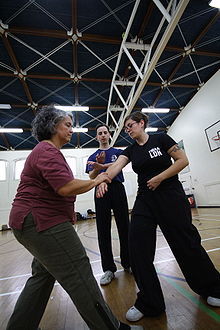Pushing hands
| Tuishou | |||||||||

Two students receive instruction in tuishou
|
|||||||||
| Chinese | |||||||||
|---|---|---|---|---|---|---|---|---|---|
|
|||||||||
| Transcriptions | |
|---|---|
| Standard Mandarin | |
| Hanyu Pinyin | tuī shǒu |
| Wade–Giles | t'ui1 shou3 |
Pushing hands, Push hands or tuishou (alternately spelled tuei shou or tuei sho) is a name for two-person training routines practiced in internal Chinese martial arts such as Baguazhang, Xingyiquan, T'ai chi ch'uan (Taijiquan), Liuhebafa, Ch'uan Fa, Yiquan. It is also played as an international sport akin to Judo, Sumo and wrestling, most notably in Taiwan, where the biannual Tai Chi World Cup is held.
Pushing hands is said to be the gateway for students to experientially understand the martial aspects of the internal martial arts (內家 nèijiā): leverage, reflex, sensitivity, timing, coordination and positioning. Pushing hands works to undo a person's natural instinct to resist force with force, teaching the body to yield to force and redirect it. Health oriented t'ai chi schools may teach push hands to complement the physical conditioning available from performing solo form routines. Push hands allows students to learn how to respond to external stimuli using techniques from their forms practice. Among other things, training with a partner allows a student to develop ting jing (listening power), the sensitivity to feel the direction and strength of a partner's intention. In that sense pushing hands is a contract between students to train in the defensive and offensive movement principles of their martial art: learning to generate, coordinate and deliver power to another and also how to effectively neutralize incoming forces in a safe environment.
Pushing hands is said by t'ai chi's Chen family to have been created by Chen Wangting (1600–1680), the founder of the Chen-style t'ai chi ch'uan, and was originally known as hitting hands (da shou) or crossing hands (ke shou). Chen was said to have devised pushing hands methods for both empty hands and when armed with a spear. Other Tai Chi schools attribute the invention of pushing hands to Zhang Sanfeng.
...
Wikipedia
